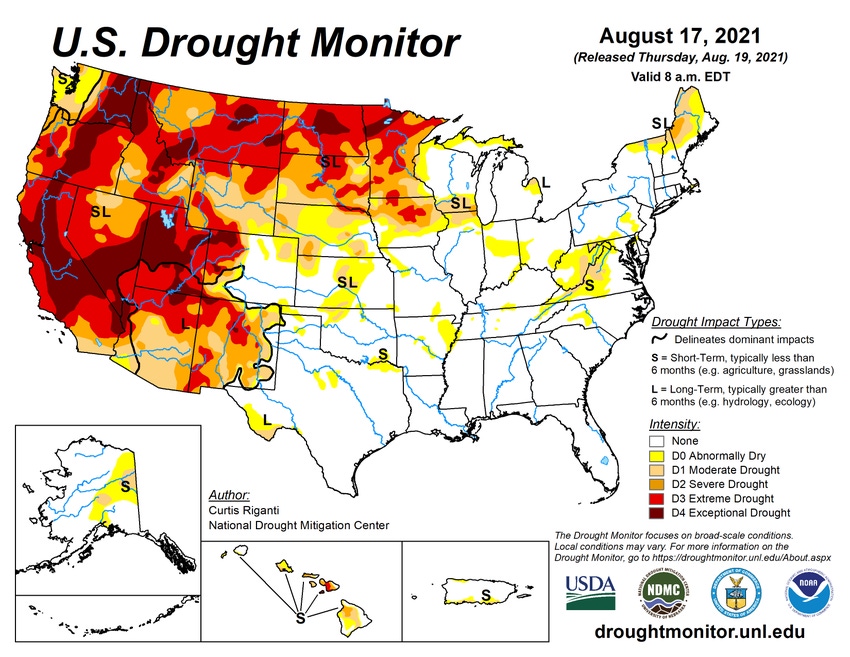El Niño may begin to emerge by the middle of 2022, bringing relief to drought-stricken areas.

National Oceanic and Atmospheric Administration (NOAA) and European climate models forecast a return of La Niña this fall, but Dr. Art Douglas, professor emeritus at Creighton University, said El Nino could reemerge by mid-year 2022. This will likely break the drought for portions of the country currently experiencing severe conditions, Douglas suggested.
In fact, the latest NOAA forecast showed an uptick in sea surface temperatures, which is the first hint toward a potential El Niño, he added.
For now, the outlook remains grim. The Aug. 19 U.S. Drought Monitor revealed 56.28% of the U.S. is experiencing some form of drought. Nearly 40% of the U.S. is in severe to exceptional drought.
Douglas said new forecasts outline drought pushing harder into the Pacific Northwest, while above-normal monsoon rains across the inter-mountain West will leave the Midwest drier.
Additionally, less tropical storm activity will reduce Southeast rainfall into late fall and a returning La Nina means the western half of the country will be drier into early spring.
Douglas relayed precipitation has been below normal for most of the U.S. for the past 260 days, especially in the West, Northern Plains and western Corn Belt.
As for the vegetation health index, Douglas said there is a lot of red in the western U.S. all the way into Minnesota. “This indicates that the vegetative greenness in that area is at the bottom 12% of years since 1982…exceedingly strong drought in the northwestern part of the country.”
Douglas said fall temperatures will be generally above normal through the midsection of the country into the Corn Belt, with most of the warmth occurring during September and the first part of October.
With the high pressure ridges again building in the Atlantic and Pacific, “we start seeing the eastern midsection of the country turning drier than normal all the way from the southeastern U.S. through Missouri up into Minnesota.”
“It’s going to be good for harvest; we’re not going to have delays due to moisture. But for finishing crops in the month of September, I think it’s going to be a real problem for both corn and beans.”
The U.S. Drought Monitor reported that as of Aug. 17, approximately 37% of U.S. corn production and approximately 31% of U.S. soybean production is within an area experiencing drought. Approximately 37% of hay production and 65% of alfalfa hay production is in areas of drought.
On the livestock side, approximately 42% of U.S. hog inventory and approximately 33% of the U.S. cattle inventory is within an area experiencing drought.
During a recent Feedstuffs 365 segment, Derrell Peel, Oklahoma State University Extension, said ongoing drought in the West already brought the first flush of cattle herd liquidation but added that the U.S. could see “quite a lot more” out of the Northern Plains as drought expands in the Dakotas, Montana and other key cattle production regions.
“That’s going to be the thing to watch as we go through the rest of the year to see whether or not this really changes the direction of this industry over the next couple years,” Peel said.
Many calves in drought areas have already been moved out, and producers are now trying to determine how many cows they can keep, he added.
Still, precipitation in other areas such as the Southern Plains, Southeast and the Mid-South has meant better conditions for cattle producers. “We’ve got good pasture conditions; sometimes we’re making hay. So, that’s where those calves are going to get backgrounded,” he said. “There will be a lot of moving of both cows and calves around the country in this context.”
About the Author(s)
You May Also Like





